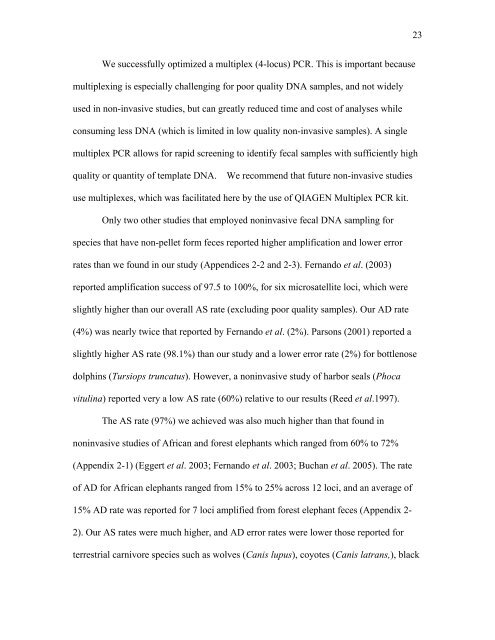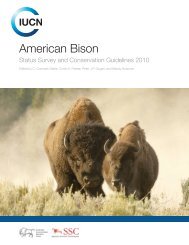Declaration Dr. Thomas H. Pringle - Buffalo Field Campaign
Declaration Dr. Thomas H. Pringle - Buffalo Field Campaign
Declaration Dr. Thomas H. Pringle - Buffalo Field Campaign
You also want an ePaper? Increase the reach of your titles
YUMPU automatically turns print PDFs into web optimized ePapers that Google loves.
We successfully optimized a multiplex (4-locus) PCR. This is important because<br />
multiplexing is especially challenging for poor quality DNA samples, and not widely<br />
used in non-invasive studies, but can greatly reduced time and cost of analyses while<br />
consuming less DNA (which is limited in low quality non-invasive samples). A single<br />
multiplex PCR allows for rapid screening to identify fecal samples with sufficiently high<br />
quality or quantity of template DNA. We recommend that future non-invasive studies<br />
use multiplexes, which was facilitated here by the use of QIAGEN Multiplex PCR kit.<br />
Only two other studies that employed noninvasive fecal DNA sampling for<br />
species that have non-pellet form feces reported higher amplification and lower error<br />
rates than we found in our study (Appendices 2-2 and 2-3). Fernando et al. (2003)<br />
reported amplification success of 97.5 to 100%, for six microsatellite loci, which were<br />
slightly higher than our overall AS rate (excluding poor quality samples). Our AD rate<br />
(4%) was nearly twice that reported by Fernando et al. (2%). Parsons (2001) reported a<br />
slightly higher AS rate (98.1%) than our study and a lower error rate (2%) for bottlenose<br />
dolphins (Tursiops truncatus). However, a noninvasive study of harbor seals (Phoca<br />
vitulina) reported very a low AS rate (60%) relative to our results (Reed et al.1997).<br />
The AS rate (97%) we achieved was also much higher than that found in<br />
noninvasive studies of African and forest elephants which ranged from 60% to 72%<br />
(Appendix 2-1) (Eggert et al. 2003; Fernando et al. 2003; Buchan et al. 2005). The rate<br />
of AD for African elephants ranged from 15% to 25% across 12 loci, and an average of<br />
15% AD rate was reported for 7 loci amplified from forest elephant feces (Appendix 2-<br />
2). Our AS rates were much higher, and AD error rates were lower those reported for<br />
terrestrial carnivore species such as wolves (Canis lupus), coyotes (Canis latrans,), black<br />
23










